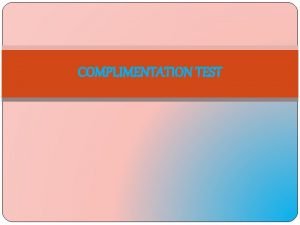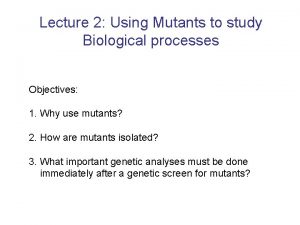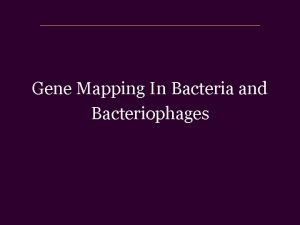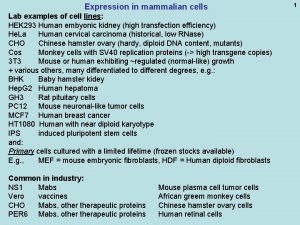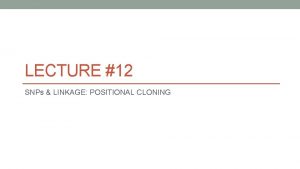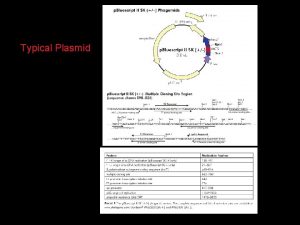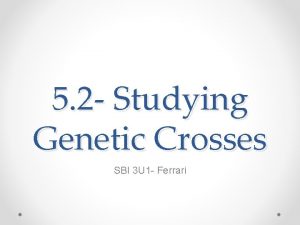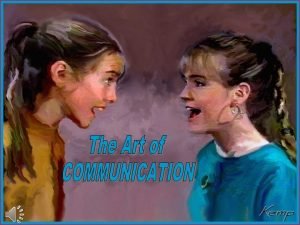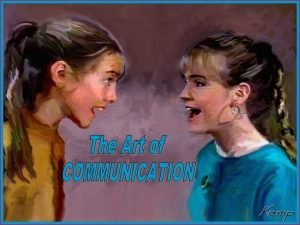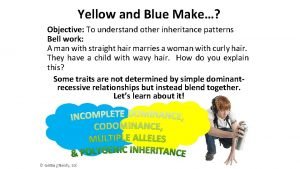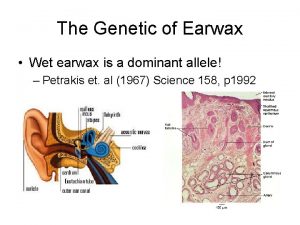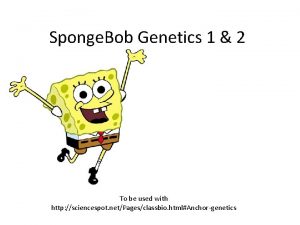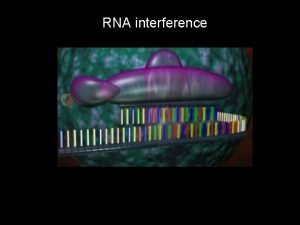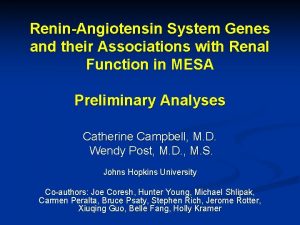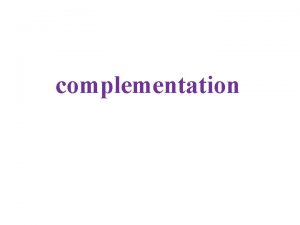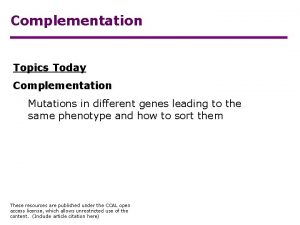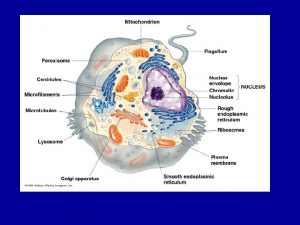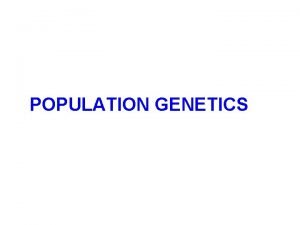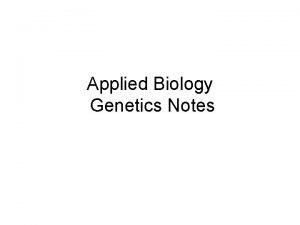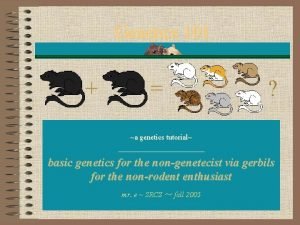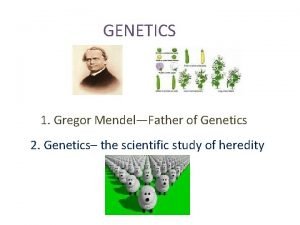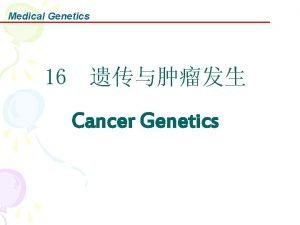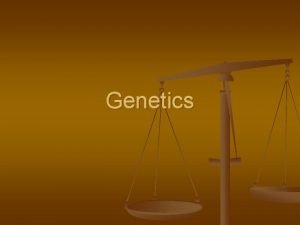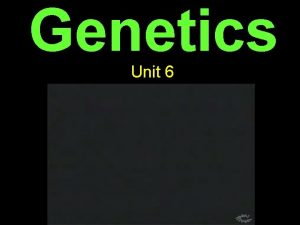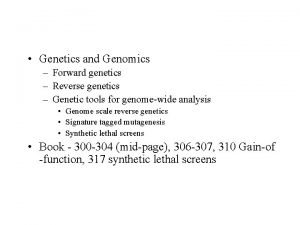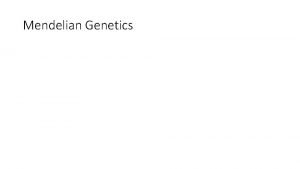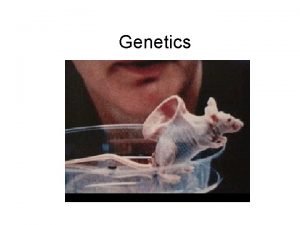COMPLIMENTATION TEST In Genetics Complementation occurs when two




















- Slides: 20

COMPLIMENTATION TEST

In Genetics, Complementation occurs when two strains of an organism with different homozygous recessive mutations that produce the same phenotype (for example, a change in wing structure in flies). Complementation will occur only if the mutations are in different genes. In this case, each strain's genome supplies the wild-type allele to "complement" the mutated allele of the other strain's genome. Since the mutations are recessive, the offspring will display the wild-type phenotype. A complementation test (sometimes called a "cis-trans" test) can be used to test whether the mutations in two strains are in different genes. The complementation test was developed by American

Example of a complementation test: Two strains of flies are white eyed. Flies from Strain 1 have complementary mutations to flies from Strain 2 because when they are crossed the offspring are able to complete the full metabolic pathway and thus have red eyes.


Knowing this, the geneticist may perform a complementation test on two separately obtained strains of pure-breeding white-eyed flies. The test is performed by crossing two flies. If the resulting progeny have red eyes, the two strains are said to complement; if the progeny have white eyes, they do not. If the strains complement, we imagine that one strain must have a genotype aa BB and the other AA bb, which when crossed yield the genotype Aa. Bb. If the strains do not complement, they both must have

Complementation tests in fungi and bacteriophage: Research on the fungus Neurospora crassa led to the development of the one-gene-one enzyme concept - foundation for the subsequent development of molecular genetics. The complementation test was one of the main tools used in the early Neurospora work, because it was easy to do, and allowed the investigator to determine whether any two nutritional mutants were defective in the same, or different genes. The complementation test was also conducted in bacteriophage T 4. In this case the test depends on mixed infections of host bacterial cells with two different bacteriophage mutant types. Its use was key to defining most of the genes of the virus, and provided the foundation for the study of such fundamental processes as DNA replication and repair, and how molecular machines are constructed.

Bacterial complementation: Bacterial genetic systems can show complementation in two important ways, each manipulating a natural process of bacterial genetics. These two processes have since been modified in biotechnology to provide most of the essential tools of gene cloning. 1. Specialized Transduction: A lysogenic bacteriophage can excise itself so as to carry a piece of host DNA by mistake. The phage will now carry a second copy of an allele (or linked alleles) into a host cell.

2. F' plasmid: The F plasmid can recombine itself into the host chromosome, then recombine itself out again with some host DNA by mistake. When it enters the next host cell, it carries a second copy of several genes; again, a partial diploid is created. In biotechnology, a plasmid can have a piece of foreign DNA ligated into it in the test tube; then the plasmid is transformed into E. coli. Then the plasmid makes many copies, including the cloned gene.

Suppressor mutation analysis: A variation on complementation is suppressor mutations. A suppressor mutation corrects a defect in a different gene locus. A mutant version of gene A makes an altered gene product, which corrects the phenotype of a defective mutation in gene B. Heterosis and the evolution of sexual reproduction: Heterosis is the tendency for hybrid individuals to exceed their pure bred parents in size and vigor. The phenomenon has long been known in animals and plants. Heterosis appears to be largely due to genetic

In general, the two fundamental aspects of sexual reproduction in eukaryotes are meiosis and outcrossing. Meiosis is proposed to be adaptive because it facilitates recombintional repair of DNA damages that are otherwise difficult to repair. Outcrossing is proposed to be adaptive because it facilitates complementation, which is the masking of deleterious recessive alleles. The benefit of masking deleterious alleles has been proposed to be a major factor in the maintenance of sexual reproduction among eukaryotes.

The Complementation Test as an Operational Definition of the Gene: Fruit flies that are homozygous for the X-linked mutations apr (now wa) and w have apricot-colored eyes and white eyes, respectively, in contrast to the red eyes of wild-type Drosophila. Lewis reported that heterozygous apr/w females had light apricotcolored eyes and produced rare red eyed progeny carrying recombinant apr+ w+ chromosomes. In addition, Lewis was able to identify progeny flies that carried X chromosomes with the reciprocal apr w recombinant genotype. the apr and w mutations were separable by recombination, and apr and w were not alleles according to the pre– 1940 concept of the gene. Lewis produced flies of genotype apr w/apr+w+, they had red eyes

The presence of different phenotypes in organisms that contain the same genetic markers, but with the markers present in different arrangements, is called a position effect, and the type of position effect observed by Lewis is referred to as a cis-trans position effect. A double heterozygote, which carries two mutations and their wild-type alleles, that is, m 1 and m 1+ plus m 2 and m 2+, can exist in either of two arrangements. When the two mutations are on the same chromosome, the arrangement is called the coupling or cis configuration; a heterozygote with this genotype is called a cis heterozygote. When the two mutations are on different chromosomes, the



Intragenic Complementation: The results of complementation tests are usually unambiguous when mutations that result in the synthesis of no gene product, partial gene products, or totally defective gene products are used. For example, deletions of segments of genes, frame shift mutations, or polypeptide chain-terminating mutations. Of course, the mutations must be recessive. When mutations causing amino acid substitutions are used, the results of complementation tests are sometimes ambiguous because of the occurrence of a phenomenon called intragenic complementation.

The functional forms of some proteins are dimmers or higher multimers consisting of two or more polypeptides. These polypeptides may be either homologous, the products of a single gene, or nonhomologous, the products of two or more distinct genes. When the active form of the protein contains two or more homologous polypeptides (it may or may not also contain nonhomologous polypeptides), intragenic complementation may occur. Let us consider an enzyme that functions as a homodimer, that is, a protein containing two copies of a specific gene product

In organisms that are homozygous for the wild-type allele of the gene, all the protein dimers will contain identical wild-type polypeptides. Similarly, organisms that are homozygous for any mutation in the gene will contain dimers with two mutant polypeptides. An organism that is heterozygous for two different mutations in the gene will produce some dimers that contain the two different mutant polypeptides. We call these heterodimers. Such heterodimers may have

Intragenic complementation sometimes occurs when the active form of an enzyme or structural protein is a multimer that contains at least two copies of any one gene product. Here, the functional form of the enzyme is a dimer composed of two polypeptides encoded by one gene. The amino acids altered by the mutations are shown as red circles in the polypeptide chains.

Limitations on the Use of the Complementation Test: 1. complementation tests are not informative in studies of dominant or codominant mutations or in cases where intragenic complementation occurs. 2. complementation tests are sometimes uninformative because of epistatic interactions between the mutant gene products. 3. Another limitation of the complementation test is encountered in working with so-called polar mutations. A polar mutation is a mutation that not only results in a defective product of the gene in which it is located, but also interferes with the expression of one or more adjacent genes. The adjacent genes are always located on one side of the gene carrying the mutation (thus the term polar mutation). Such polar mutations are frequently observed in prokaryotes in coordinately regulated sets of genes called operons. They usually are mutations resulting in polypeptide chaintermination signals (nucleotide-pair triplets yielding UAA, UAG, and UGA codons in m. RNA) within genes. These polar mutations interfere with the expression of genes located downstream (relative to the direction of transcription) of the mutant gene. As a result, polar mutations fail to complement mutations in genes subject to the polar effect

 Complementation test in bacteriophage
Complementation test in bacteriophage Complementation test
Complementation test Benzer's experiment
Benzer's experiment Cfl closure properties
Cfl closure properties Structure of complementation
Structure of complementation Protein fragment complementation assay
Protein fragment complementation assay Complementation assay
Complementation assay Are eggs hbv or lbv
Are eggs hbv or lbv Over consumption of fat
Over consumption of fat Protein complementation
Protein complementation Alpha complementation
Alpha complementation Sbi3u genetics test
Sbi3u genetics test It is a good condition that good communication occurs
It is a good condition that good communication occurs It is a good condition that good communication occurs
It is a good condition that good communication occurs Blue and yellow make
Blue and yellow make Earwax type genetics
Earwax type genetics Spongebob's aunt and uncle sponge wilma and sponge wilbur
Spongebob's aunt and uncle sponge wilma and sponge wilbur Silkie colors
Silkie colors Section 1 meiosis
Section 1 meiosis Forward genetics
Forward genetics Genetics model
Genetics model
